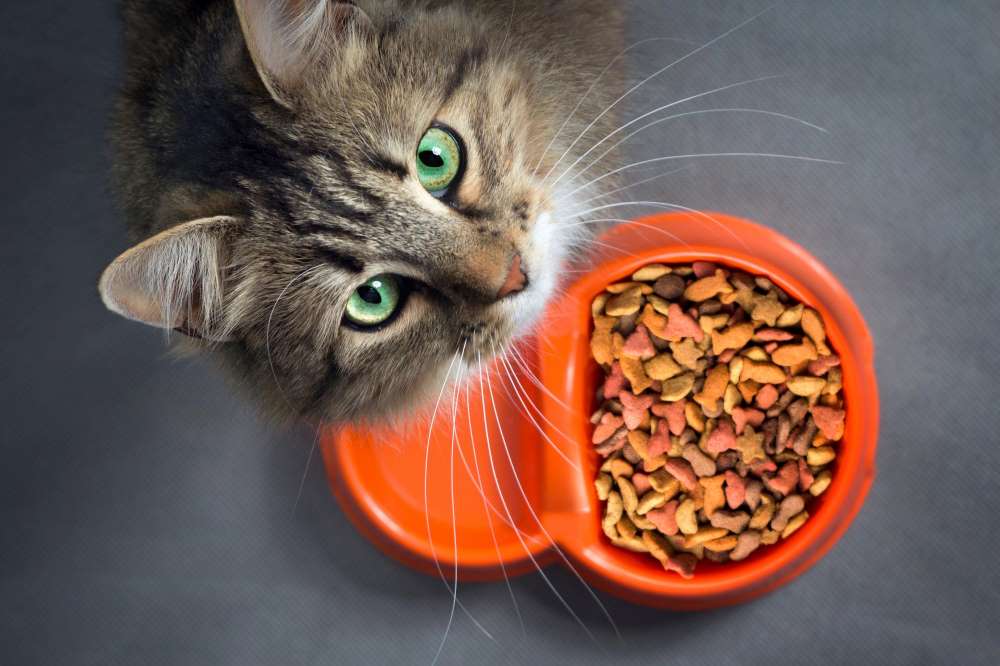How To Make Dry Cat Food

Crafting nutritionally balanced meals for our pets is a responsibility many cat owners take on with dedication and care. In this article we will discuss how to make dry cat food at home, focusing on the essential elements required for a wholesome diet.
Understanding the unique nutritional needs of cats is paramount as we select high-quality ingredients to create a well-rounded and tailored meal plan. From the importance of proteins and healthy fats to incorporating the right carbohydrates, we aim to provide a comprehensive guide for cat owners seeking to enhance their pets’ nutrition.
By following these steps and maintaining a keen eye on portion sizes and storage practices, cat owners can ensure their pets enjoy a diet that supports their overall health and well-being.
Understanding Cat Nutrition
Before you start to make dry cat food, it is important to have an understanding of cat nutrition. Cats, as obligate carnivores, necessitate a diet rich in high-quality proteins, a fundamental component when formulating dry cat food. Exploring protein sources like chicken, turkey, and fish becomes crucial for promoting muscle development and overall feline vitality.
The incorporation of essential fatty acids, derived from oils like fish oil and olive oil, not only enhances flavor but also contributes to coat health and immune system support. Moreover, comprehending the role of minimal carbohydrates and selecting appropriate sources such as whole grains and vegetables is essential for providing the necessary energy in a dry cat food recipe.
By honing in on these nutritional nuances, cat owners can tailor their homemade dry cat food to meet the specific dietary needs of their feline companions, fostering a foundation of health and well-being.
Selecting Ingredients for Homemade Dry Cat Food
In the pursuit of crafting homemade dry cat food, the careful selection of ingredients plays a pivotal role in ensuring a nutritionally balanced and wholesome diet for feline companions.
- High-Quality Protein Sources: Serving as the foundation of a cat’s diet, protein is indispensable for muscle development, maintenance, and overall vitality. Opt for a diverse array of meat options, including chicken, turkey, beef, and fish, to provide a comprehensive spectrum of essential amino acids crucial for feline health.
- Healthy Fats: Essential fatty acids, such as Omega-3 and Omega-6, are vital contributors to a cat’s coat health, immune system, and overall well-being. Integrate oils like fish oil and olive oil into the diet to infuse these beneficial fats, promoting optimal feline health.
- Carbohydrates for Energy: Despite being obligate carnivores, cats benefit from the inclusion of some carbohydrates for energy. Select whole grains like brown rice and oats, alongside nutrient-rich vegetables, to establish a balanced carbohydrate profile that complements their dietary needs.
- Avoiding Harmful Additives and Preservatives: Prioritize natural ingredients while steering clear of artificial additives and preservatives. The exclusion of these potentially harmful elements safeguards against long-term health issues, ensuring the nutritional integrity of the homemade dry cat food.
Making Homemade Dry Cat Food: Step-by-Step Recipes

Creating nutritious and flavorful dry cat food at home involves a careful selection of ingredients and a meticulous preparation process. Here are two recipes to guide you through the steps:
Recipe 1: Chicken and Brown Rice Delight
Ingredients:
- 1 cup boneless, skinless chicken thighs
- 1 cup cooked brown rice
- 1/4 cup carrots, finely chopped
- 1/4 cup peas
- 1 tablespoon fish oil
Steps:
- Cook the chicken thighs thoroughly and allow them to cool. Once cooled, finely chop or shred the chicken into small, bite-sized pieces.
- In a large mixing bowl, combine the cooked brown rice, chopped carrots, peas, and shredded chicken.
- Add fish oil to the mixture, ensuring even distribution. Fish oil provides essential omega-3 fatty acids for coat health and overall well-being.
- Mix the ingredients thoroughly until well combined. Adjust the texture based on your cat’s preferences, considering either finely ground or slightly coarser consistency.
- Spread the mixture onto a baking sheet in a thin layer.
- Bake in a preheated oven at 350°F (175°C) for approximately 20-25 minutes or until the mixture is thoroughly dried.
- Allow the homemade dry cat food to cool completely before storing it in an airtight container.
Recipe 2: Fish and Sweet Potato Crunch
Ingredients:
- 1 cup canned tuna in water, drained
- 1/2 cup cooked sweet potato, mashed
- 1/4 cup spinach, finely chopped
- 1 tablespoon olive oil
Steps:
- Drain the canned tuna and place it in a large mixing bowl.
- Add the mashed sweet potato and finely chopped spinach to the bowl.
- Incorporate olive oil into the mixture for added healthy fats.
- Mix all the ingredients thoroughly, ensuring an even distribution of flavors.
- Adjust the texture to your cat’s liking, whether finely ground or with small, identifiable pieces.
- Lay the mixture on a dehydrator tray, spreading it thinly and evenly.
- Dehydrate at 150°F (65°C) for approximately 4-6 hours or until the mixture reaches a crunchy texture.
- Once dehydrated, allow the cat food to cool completely before storing it in an airtight container.
Recipe 3: Turkey and Quinoa Bliss
Ingredients:
- 1 cup ground turkey
- 1/2 cup cooked quinoa
- 1/4 cup zucchini, grated
- 1/4 cup cranberries (unsweetened, dried)
- 1 tablespoon coconut oil
Steps:
- Cook the ground turkey thoroughly and allow it to cool. Once cooled, combine it with cooked quinoa in a mixing bowl.
- Add grated zucchini and cranberries to the mixture, providing additional fiber and nutrients.
- Incorporate coconut oil for its nutritional benefits and to enhance the overall flavor.
- Mix all ingredients thoroughly, ensuring an even distribution of flavors and textures.
- Adjust the texture based on your cat’s preferences, aiming for a balanced consistency.
- Spread the mixture on a baking sheet and bake at 350°F (175°C) for approximately 20-25 minutes or until the cat food is dry and crispy.
- Let the homemade dry cat food cool completely before storing it in an airtight container.
Recipe 4: Salmon and Oat Medley
Ingredients:
- 1 cup canned salmon, drained
- 1/2 cup oats (cooked or instant)
- 1/4 cup broccoli, finely chopped
- 1/4 cup blueberries (fresh or frozen)
- 1 tablespoon flaxseed oil
Steps:
- Drain canned salmon and place it in a mixing bowl.
- Combine oats (cooked or instant) with the salmon, providing a source of whole grains for energy.
- Add finely chopped broccoli and blueberries for added vitamins and antioxidants.
- Integrate flaxseed oil into the mixture, enhancing the omega-3 fatty acid content.
- Thoroughly mix all ingredients, ensuring an even distribution of flavors.
- Adjust the texture according to your cat’s preferences, aiming for a desirable consistency.
- Lay the mixture on a dehydrator tray and dehydrate at 150°F (65°C) for 4-6 hours or until the cat food achieves a crisp texture.
- Allow the homemade dry cat food to cool completely before storing it in an airtight container.
Recipe 5: Beef and Pumpkin Crunch
Ingredients:
- 1 cup lean ground beef
- 1/2 cup canned pumpkin (unsweetened)
- 1/4 cup carrots, grated
- 1/4 cup parsley, finely chopped
- 1 tablespoon sunflower oil
Steps:
- Cook lean ground beef thoroughly and let it cool. In a mixing bowl, combine it with canned pumpkin.
- Add grated carrots and finely chopped parsley for additional nutrients and flavor.
- Integrate sunflower oil for its nutritional benefits, enhancing the overall health profile.
- Thoroughly mix all ingredients, ensuring an even distribution of flavors and textures.
- Adjust the texture based on your cat’s preferences, aiming for a balanced consistency.
- Spread the mixture onto a baking sheet and bake at 350°F (175°C) for 20-25 minutes or until the cat food achieves a dry and crunchy texture.
- Once baked, allow the homemade dry cat food to cool completely before storing it in an airtight container.
These diverse recipes offer a range of flavors and nutritional benefits, catering to various feline palates and dietary requirements. Remember to introduce new recipes gradually, monitor your cat’s response, and consult with a veterinarian to ensure these homemade options align with their specific nutritional needs.
Storing Homemade Dry Cat Food
Ensuring the longevity and nutritional integrity of homemade dry cat food hinges on proper storage practices. Invest in airtight containers to shield the food from moisture, air, and light, preserving its freshness and preventing spoilage. Label containers with clear expiration dates, facilitating easy monitoring of the cat food’s shelf life.
Store the containers in a cool, dry place, away from direct sunlight, to maintain optimal quality. Periodically check for signs of spoilage, such as off-putting odors or changes in color and texture.
By adhering to these storage guidelines, cat owners can guarantee that their carefully crafted homemade dry cat food remains a wholesome and nutritious delight for their feline companions, contributing to their overall health and well-being.
Conclusion
In conclusion, creating homemade dry cat food is a gratifying endeavor that allows pet owners to take an active role in their cat’s nutrition. By understanding the nutritional needs of cats, carefully selecting ingredients, and following a balanced recipe, cat owners can provide their feline companions with a diet that promotes vitality and longevity.
While the process requires dedication and attention to detail, the rewards of a healthy and content cat make the effort worthwhile. Always consult with a veterinarian for professional guidance and embark on the journey of crafting nutritious delights that contribute to a flourishing feline life.


